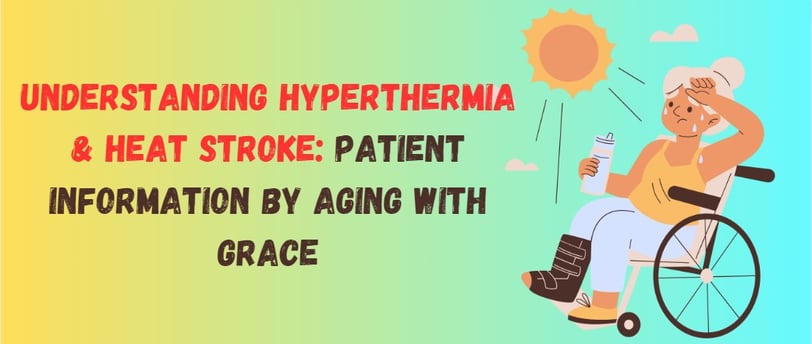Understanding Hyperthermia & Heat Stroke: Patient information by Aging with Grace
It is crucial for patients, especially seniors and those living in cities where is can get extremely hot, to be aware of heatstroke and its potential risks. Aging individuals are more susceptible to heat-related illnesses due to physiological changes that affect their ability to regulate body temperature. By understanding the signs and symptoms of heatstroke, patients can take proactive measures to prevent its occurrence. This knowledge empowers them to stay hydrated, avoid excessive heat exposure, and seek immediate medical assistance if they experience symptoms of heatstroke. At Aging with Grace, we prioritize patient education to ensure their safety and well-being during hot weather conditions.
Dr. Rishabh Siddarth Harinarain MBBS, PGDHM - Founder Aging with Grace
6/8/20233 min read


Hyperthermia, also known as heat illness or simply put, overheating of the body. It occurs due to an abnormally high body temperature. It is the opposite of hypothermia, which occurs when the body gets too cold. Hyperthermia happens when the body absorbs or generates more heat than it can release. Normally, a human body temperature hovers around 98.6 degrees Fahrenheit, and any temperature above 99 or 100 degrees Fahrenheit is considered too warm. In most cases, hyperthermia is the result of overexertion in hot and humid conditions and in extreme cases heatstroke, which can be a life-threatening condition. Fortunately, many forms of hyperthermia including heatstroke can be prevented.
Different Types of Hyperthermia: Hyperthermia encompasses a range of heat-related illnesses, progressing from least severe to most severe:
Heat cramps: Excessive loss of electrolytes (important substances in body fluids) through sweating can lead to muscle cramps. Heat cramps typically affect the arms, hands, lower legs, and feet.
Heat exhaustion: More serious than heat cramps, heat exhaustion is characterized by body temperatures as high as 104 degrees Fahrenheit. If left untreated, heat exhaustion can progress to heatstroke.
Heat rash: Excessive sweating in hot and humid weather can cause a skin irritation known as heat rash. It appears as small red pimples or blisters, commonly occurring in the elbow crease, under the breasts, near the groin, or on the upper chest and neck.
Heat stress: Individuals working in hot conditions, such as fire fighters, miners, and construction workers, may experience occupational heat stress. It can lead to heat exhaustion or heatstroke if not managed properly.
Heatstroke: The most severe form of hyperthermia, heatstroke is a life-threatening condition that causes the body temperature to rise above 104 degrees Fahrenheit. It can result in serious complications in the brain and other organs. Heatstroke becomes particularly dangerous when the body temperature exceeds 106 degrees Fahrenheit.
Distinguishing Hyperthermia from Fever It's important to note that hyperthermia is not the same as a fever. Fever is typically caused by an immune response to an infection or illness. It is a physiological response triggered by the body's immune system to combat pathogens. On the other hand, heatstroke is primarily caused by external factors, such as prolonged exposure to high temperatures or engaging in vigorous physical activity in hot and humid conditions.
Medical Emergency: While a fever is a common symptom of various illnesses and infections, it is generally not considered a medical emergency unless it persists for an extended period or reaches very high temperatures. Heatstroke, on the other hand, is a medical emergency that requires immediate attention and can be life-threatening if not treated promptly.
What are the symptoms of Hyperthermia?
Recognizing the symptoms of hyperthermia is crucial for individuals' well-being, especially for those under the care of Aging with Grace. Heat cramps can cause sudden muscle spasms in various parts of the body, resulting in pain and muscle soreness. Heat exhaustion is characterized by symptoms such as:
Blurred vision
Dizziness
Rapid breathing or heart rate
Fatigue
Headache
Lightheadedness or fainting
Low blood pressure
Muscle aches or cramps
Nausea, vomiting, and weakness.
Heatstroke symptoms may resemble those of heat exhaustion but can also include
Anhidrosis (lack of sweating)
Balance problems
Confusion and delirium
Hot or pale skin
Low or high blood pressure
Seizures.
It's important to note that heatstroke can be life-threatening, leading to shock, coma, organ failure, or even death. If you or someone you know experiences symptoms of heatstroke, immediate medical attention should be sought. By being aware of these symptoms, Aging with Grace patients can take prompt action to protect their health and well-being.
At Aging with Grace, we understand the importance of providing exceptional home and nursing care services, including identifying the signs, carefully managing and suggesting ways to avoid heatstroke in Chennai. Our dedicated team of caregivers is trained to understanding vital signs and how to measure them, preventing overheating, and promote a safe and comfortable environment for our loved ones. With our professional and compassionate approach, we strive to ensure the well-being and comfort of our clients, helping them age with grace in the comfort of their own homes.


Let's talk!
info@agingwithgrace.in
+91 93630 23232
River View Enclave, Manapakkam
Chennai - 600125
